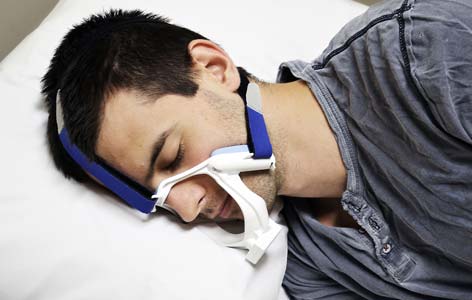Home page Description:
Convenient at-home device can be used to accurately diagnose sleep apnea.
Posted On: May 04, 2016

Image Caption:
A new device (pictured above) that was developed at UHN could help reach the estimated 18 million people in North America that are currently undiagnosed for sleep apnea.
People with sleep apnea experience pauses in breathing during sleep. These pauses can last 10 to 90 seconds and can occur as many as 100 times per hour. The repercussions are serious: those with the most common form of sleep apnea (known as obstructive sleep apnea) are at increased risk of high blood pressure, stroke and heart disease.
While effective treatments for sleep apnea exist, the majority of people with sleep apnea do not know that they have it. This is partly the result of how sleep apnea is currently diagnosed; individuals must be monitored overnight in a sleep laboratory—a process that is inconvenient and depends on limited resources.
To help improve the low rates of sleep apnea diagnosis, researchers led by TRI Scientist Dr. Hisham Alshaer have developed a device that can be used to diagnose sleep apnea at home. The device, called BresoDx® (formerly ApneaDx), is worn comfortably on one’s face during sleep and works by recording and analyzing the sounds of breathing.
While the device was first shown to have potential at diagnosing sleep apnea in 2013, the researchers’ latest study proved the accuracy of the device versus existing in-laboratory diagnosis in institutional settings as well as in patients’ homes.
Dr. Alshaer explains, “We simultaneously measured sleep apnea using the BresoDx® and traditional methods in 135 individuals in a sleep laboratory. The findings revealed that our device was able to diagnose sleep apnea with similar accuracy. Furthermore, the high levels of accuracy were upheld when study participants used the device unsupervised in their own homes.”
When combined with a physician consultation, use of the device may represent an important way to improve rates of sleep apnea diagnosis.
This work was supported by the Ministry of Research and Innovation, MaRS Innovation, Ontario Centres of Excellence, Johnson and Johnson Inc., the Natural Sciences and Engineering Research Council of Canada, the Ontario Brain Institute, the Ontario Ministry of Health and Long-Term Care, and the Toronto Rehab Foundation. TD Bradley is supported by the Clifford Nordal Chair in Sleep Apnea and Rehabilitation Research.
Comparison of in-laboratory and home diagnosis of sleep apnea using a cordless portable acoustic device. Alshaer H, Fernie GR, Tseng WH, Bradley TD. Sleep Medicine. 2015 Dec 2. doi: 10.1016/j.sleep.2015.11.003. [Pubmed abstract]
While effective treatments for sleep apnea exist, the majority of people with sleep apnea do not know that they have it. This is partly the result of how sleep apnea is currently diagnosed; individuals must be monitored overnight in a sleep laboratory—a process that is inconvenient and depends on limited resources.
To help improve the low rates of sleep apnea diagnosis, researchers led by TRI Scientist Dr. Hisham Alshaer have developed a device that can be used to diagnose sleep apnea at home. The device, called BresoDx® (formerly ApneaDx), is worn comfortably on one’s face during sleep and works by recording and analyzing the sounds of breathing.
While the device was first shown to have potential at diagnosing sleep apnea in 2013, the researchers’ latest study proved the accuracy of the device versus existing in-laboratory diagnosis in institutional settings as well as in patients’ homes.
Dr. Alshaer explains, “We simultaneously measured sleep apnea using the BresoDx® and traditional methods in 135 individuals in a sleep laboratory. The findings revealed that our device was able to diagnose sleep apnea with similar accuracy. Furthermore, the high levels of accuracy were upheld when study participants used the device unsupervised in their own homes.”
When combined with a physician consultation, use of the device may represent an important way to improve rates of sleep apnea diagnosis.
This work was supported by the Ministry of Research and Innovation, MaRS Innovation, Ontario Centres of Excellence, Johnson and Johnson Inc., the Natural Sciences and Engineering Research Council of Canada, the Ontario Brain Institute, the Ontario Ministry of Health and Long-Term Care, and the Toronto Rehab Foundation. TD Bradley is supported by the Clifford Nordal Chair in Sleep Apnea and Rehabilitation Research.
Comparison of in-laboratory and home diagnosis of sleep apnea using a cordless portable acoustic device. Alshaer H, Fernie GR, Tseng WH, Bradley TD. Sleep Medicine. 2015 Dec 2. doi: 10.1016/j.sleep.2015.11.003. [Pubmed abstract]




